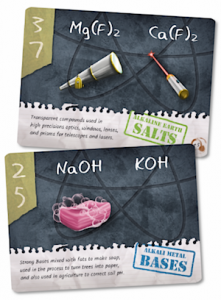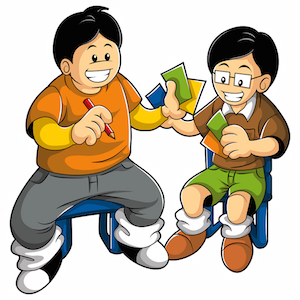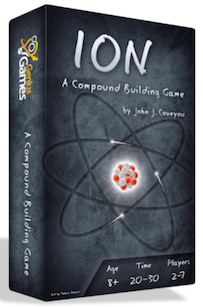Using Games to Teach Core Science Concepts
by John Coveyou
What is the biggest hurdle you face as a science teacher? Here are three I often encounter:
► Students are intimidated by the complex ideas and new terms they encounter in science content;
► They’re afraid of failure so only give science studies a marginal attempt;
► They have many other things competing for their attention which offer more immediate rewards.
Here’s the problem the way I see it
In the United States, student literacy in STEM-related subjects (that’s Science, Technology, Engineering and Mathematics) has seen a steady downward slide in recent decades. Currently, our students rank at the 52nd percentile for STEM literacy when compared with their peers around the globe. But that’s not the whole picture.

It is apparent that our future leaders are frequently dodging their prescribed science and math curriculum for the very different experience of game play.
Clearly, we educators are trying to remedy this imbalance. The U.S. spends a lot of money promoting student competency in the sciences, in an effort to interest and engage students in pursuing high value careers. Do a Google search for “STEM Initiative” and you’ll be stunned by the plethora of worthy projects currently under way to reignite the interest of the next generation in the hard and applied sciences.
But it is equally clear that many of these methods, loudly touted for the past couple of decades, haven’t been working.
Think about this from the student perspective
Students know they ‘ought’ to do well in their science and math classes, and they know the long-term benefits of a good education and careers in these fields. Ask them yourself! But most students stop at wishing they were ‘better at’ those subjects.
We spoon feed our next generation the benefits of science and math education at a young age. So, what’s stopping more students from succeeding in these subjects?
The three factors I highlighted above are a big part of it: students are intimidated by the challenge of learning new and complex material, so they don’t try very hard and spend their time pursuing more instant gratification.

Why games work
Some of the toughest challenges we face in educating our youth lie not in designing the curriculum or selecting the content but in communicating despite the negative temperaments or uninterested disposition of the students. So why not start there?
What do kids most naturally start doing when we leave them to themselves? They start playing. Play is natural.
We think of school as a place where students must stop playing, so that they can start learning. But why do these pursuits have to be mutually exclusive? We tell our students to “stop playing around” – but if play is so natural, why not harness it instead of fighting against it?
The benefits of games in education
One remarkable thing about games is that they remove much of the intimidation inherent in the learning process (the feeling of dread that surfaces whenever students are faced with new vocabulary, multi-step processes and/or complex concepts). Watch a group of students play a game they are familiar with, and this becomes so obvious.

Games also speed up the ‘fail, learn, grow’ iterative loop, and they do so (most importantly) without the emotional weight of grades and tests. Those can come later.
And for those students who may be a bit worried about working in groups… have you seen how they act with their friends on the playground? Or around a board game or foosball table? Inside classroom walls games can encourage that same spirit of camaraderie and comfortability, promoting group interaction over multitude complex topics.
A good game provides an opportunity to participate not only verbally and visually, but also in a tactile way. This is a breakthrough for more kinetic learner types. That was me!
Out with the old, in with the new
With science and math, there are a lot of fundamentals to learn before one gets to the fun STEM projects – to investigation, implementation, and discovery. And arguably, for centuries now those prerequisite fundamentals have been served up in a dry and un-engaging manner – via the academic textbook.
Years of rote-memory work, urged upon students with the attendant promise of far-off significance and socio-economic success (or failure), cannot compete with the world of the game – the world where everything matters right now but never so much that one can’t start over (free of lasting shame if one fails the current test).
Games make failure acceptable and even turn failure into a learning opportunity instead of an occasion for collecting shame or fear of not succeeding. In games, learning happens whether you win or lose.
Here’s my pitch
Outside of teaching, I design science-themed games that I know will rock the classroom. I plan to publish my next game, ION: A Compound Building Game, through Kickstarter and would love it if you would partner with me in helping my dream of publishing more science games come true.

In play-testing, students typically master the “big ideas” of ionic bonding and why elements of one ‘group’ tend to bond with specific elements from other groups. And they master this much more quickly than they do through typical activities like worksheets. You can download the prototype rules for ION if you’d like to take a look. If this seems like a project worthy of some support, I hope you’ll join my Kickstarter campaign (April 8 to May 6th).
John Coveyou currently teaches middle grades chemistry and physics and has also taught the core sciences at all grade levels from the middle grades to college. A St. Louis native, he attended Washington University, earning a bachelors’ degree in biology and a master’s degree in engineering. John started Genius Games “with the mission of using games to cultivate a joy for science and stimulate inquisitive minds.” His first game, Linkage: A DNA Card Game, was featured in Popular Science Magazine as one of “The 10 Best Things from February 2015.”


































